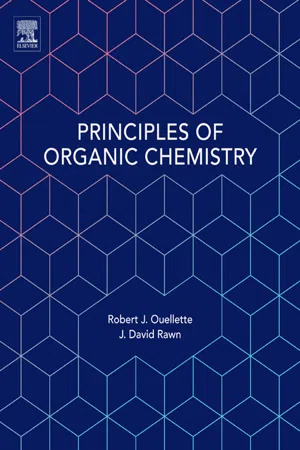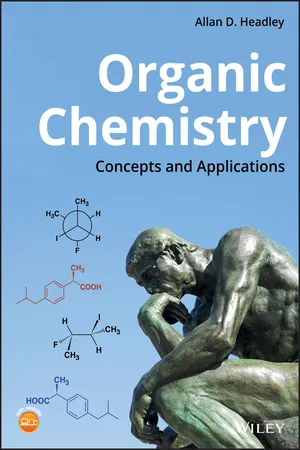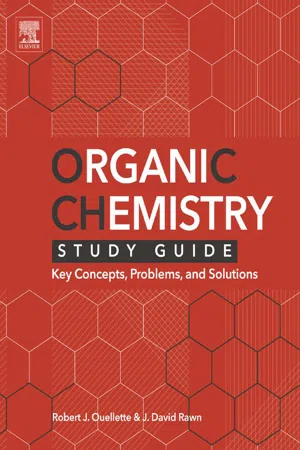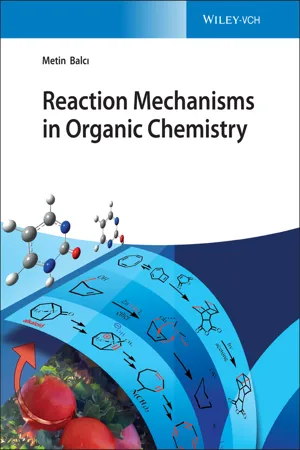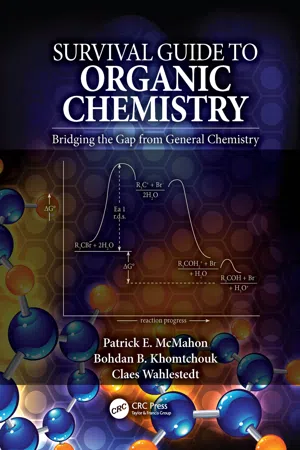Chemistry
Reactions of Haloalkanes
The reactions of haloalkanes involve the substitution of the halogen atom with another functional group. Common reactions include nucleophilic substitution, where a nucleophile replaces the halogen, and elimination reactions, where the halogen is removed along with a hydrogen atom to form a double bond. These reactions are important in organic synthesis and the production of various organic compounds.
Written by Perlego with AI-assistance
Related key terms
Related key terms
1 of 4
Related key terms
1 of 3
5 Key excerpts on "Reactions of Haloalkanes"
- eBook - ePub
- Robert J. Ouellette, J. David Rawn(Authors)
- 2015(Publication Date)
- Elsevier(Publisher)
7Nucleophilic Substitution and Elimination Reactions
7.1 Reaction Mechanisms and Haloalkanes
We introduced the concept of functional groups and their role in the organization of the structures of organic molecules in Section 1.9 . We described the importance of reaction mechanisms as an organizational device to classify chemical reactions in Section 2.9 . The details of the electrophilic addition reactions of alkenes (Section 4.9 ) and electrophilic substitution reactions of aromatic compounds (Section 5.5 ) are examples of two important reaction mechanisms. In this chapter we examine two more types of reactions mechanisms—nucleophilic substitution and elimination reactions. These mechanisms often occur in competition with one another and describe the reactions of several classes of compounds, such as haloalkanes (also called alkyl halides) and alcohols. In this chapter we focus on the substitution and elimination Reactions of Haloalkanes. These reactions illustrate the role of structure in determining the degree to which a given reaction mechanisms occurs.Reactivity of Haloalkanes
Haloalkanes have a halogen atom bonded to an sp3 -hybridized carbon atom. As a result of the greater electronegativity of the halogens, the carbon atom of the carbon-halogen bond bears a partial positive charge and the halogen atom has a partial negative charge.where X = F, Cl, Br, ISince a carbon-halogen bond is polar, a haloalkane has two sites of reactivity. One is at the carbon atom bonded to the halogen atom. This carbon atom is electropositive and reacts with nucleophiles. The second site of reactivity in a haloalkane is the hydrogen atom bonded to the carbon atom adjacent to the carbon atom bonded to the halogen atom. This hydrogen atom is more acidic than the hydrogen atoms in alkanes because the halogen atom on the adjacent carbon atom withdraws electron density by an inductive effect. - eBook - ePub
Organic Chemistry
Concepts and Applications
- Allan D. Headley(Author)
- 2019(Publication Date)
- Wiley(Publisher)
Alkanes are fairly inert compounds; some alkanes are used as solvents to provide inert media for different reactions that we will see in later chapters. In addition to combustion, alkanes undergo another type of reaction that is very important to organic chemists, and that is the reaction with halogens, specifically chlorine or bromine in the presence of energy in the form of heat or light. As the name suggests, this reaction involves the reaction of alkanes and bromine or chlorine and is called bromination or chlorination of alkanes, respectively. These reactions are performed in the presence of light or heat and are described as substitution reactions since a hydrogen or more than one hydrogen atoms of an alkane reactant are substituted for a halogen or more than one halogen in the product. Most of the reactions that will be encountered in this chapter involve the substitution of one hydrogen in the alkane for a halogen in the product.The products produced upon the chlorination of alkanes are alkyl halides, most are important industrial raw material for the synthesis of numerous other chemicals. For example, chloromethane was used once as a refrigerant, but discontinued owing to its flammability and toxicity. Today, it is widely used as a chemical intermediate for the production of different compounds, including polymers. Other chloroalkanes are widely used as a solvent in the research labs and in the production of rubber and in the petroleum refining industry. The chlorination of methane is shown in Reaction (14‐5) .(14‐5)To be able to predict the products of these and other similar reactions, a thorough understanding of how the reaction occurs is essential. Before we examine the reaction mechanism for the chlorination of alkanes, let us examine the process of bond reorganization for the reaction shown in Reaction (14‐5) . It should be obvious that this reaction is a substitution reaction in which a Cl─Cl bond has to be broken and the chlorine atoms form two new bonds, a new H─Cl bond and a new C─Cl bond in the CH3 - eBook - ePub
Organic Chemistry Study Guide
Key Concepts, Problems, and Solutions
- Robert J. Ouellette, J. David Rawn(Authors)
- 2014(Publication Date)
- Elsevier(Publisher)
9Haloalkanes and Alcohols Introduction to Nucleophilic Substitution and Elimination Reactions
Keys to the Chapter
9.1 Functionalized Hydrocarbons
In this chapter, we discuss the chemistry of haloalkanes and alcohols in which the halogen or hydroxy! group is bonded to an sp3 -hybridized carbon atom. Molecules with sp2 -hybridized carbon atoms bonded to a halogen or a hydroxyl group have different chemistry. We will discuss these compounds in later chapters. Haloalkanes and alcohols are classified as 1°, 2°, and 3° by the same method used to classify carbon atoms in alkanes.9.2 Nomenclature of Haloalkanes
The rules for naming haloalkanes are very similar to the rules for naming alkanes (Section 4.3 ) and alkenes (Section 5.6 ). Halogen atoms and branching alkyl groups have equal priorities in terms of their positions in the parent chain. If no other functional groups are present, the chain is numbered from the end closest to the first substituent, whether it is a halogen or an alkyl group. However, the double bond of an alkene or the triple bond of an alkyne takes precedence in numbering a carbon chain, regardless of where the halogen is located or how many halogens there may be. The concept of the priority of one functional group over another is expanded with each new functional group we will study in later chapters. It is explicitly part of R ,S configurational nomenclature.9.3 Nomenclature of Alcohols
The common names of simple alcohols are based on the name of the alkyl group bonded to the hydroxyl group, as in methyl alcohol. The IUPAC method of naming alcohols is based on the longest continuous carbon chain that contains a hydroxyl group. The chain is numbered to give the carbon atom bonded to the hydroxyl group the lowest possible number. The suffix -ol - eBook - ePub
- Metin Balc?, Metin Balc?, Metin Balc?, Metin Balc?, Metin Balc?(Authors)
- 2021(Publication Date)
- Wiley-VCH(Publisher)
2 O. The reaction proceeds according to Markovnikov's rule. The proton adds to the less substituted carbon atom, while the alkoxy group adds to the more substituted carbon atom. There is no stereospecificity associated with this reaction because the intermediate formed is a carbocation, which can be attacked from both faces of the planar carbocation.4.3.3 Formation of Halohydrins
When alkenes react with halogens in non-nucleophilic solvents such as carbon tetrachloride and chloroform, they produce vicinal 1,2-dihalides. If the reaction is performed in a nucleophilic solvent such as water, the solvent becomes the nucleophile in the second step and reacts with the halonium ion to form halohydrins.As the halogen approaches the alkene, the π-bond electrons will repel the electrons in the halogen–halogen bond, leaving the nearer halogen slightly positive as shown below. First, a cyclic halonium ion is formed because the halogen is the only electrophile. The halogen accepts the π-bond electrons from the double bond and forms a bromonium (or chloronium) ion. The unstable cyclic halonium ion rapidly reacts with the nucleophile, water, because it is present in a much higher percentage than the halide anion. An anti-stereoselectivity is observed during the addition because the solvent approaches the halonium ion from the back. For example, the addition of bromine to cyclopentene in the presence of water gives trans-2-bromocyclopentanol.If the halonium ion formed has a symmetrical structure, the nucleophile attacks both carbon atoms with the same probability. However, if the halonium ion is not symmetrical, a regioselectivity is observed by the same mechanism we used to rationalize Markovnikov's rule. When propene reacts with bromine and water, the major product has the electrophile bonded to the less substituted carbon atom of the double bond, while the hydroxyl group is bonded to the more substituted carbon atom. - eBook - ePub
Survival Guide to Organic Chemistry
Bridging the Gap from General Chemistry
- Patrick E. McMahon, Bohdan B. Khomtchouk, Claes Wahlestedt(Authors)
- 2016(Publication Date)
- CRC Press(Publisher)
electron donation .- Directly attached carbon groups (alkyl-substituent groups) are more efficient than substituted hydrogen atoms at donation of electron density to electrophilic carbon. This is due to the versatility (inductive and hyperconjugative effects) of the bonding electrons in the carbon group.
- The net result is that a positive charge or radical on electrophilic carbon is more stable (i.e., "“less unfavorable”) whenever the electrophilic carbon itself is bonded to the greatest number of alkyl groups (carbon groups ).
- Summary:
12.2 FREE RADICAL HALOGENATION OF ALKANES/ALKYL GROUPS
12.2.1 REACTION CONCEPTS
- The overall reaction is a net substitution of a hydrogen for a halogen in an alkane to form an alkyl halide; the other product is a hydrogen halide. The carbon being substituted can be methyl, primary, secondary, or tertiary. The halogen is usually either diatomic Cl2 or Br2 . Light often is used to initiate the reaction.
- The rate of the reaction depends primarily on the alkyl-substitution pattern of the carbon which undergoes the halogen/hydrogen exchange.
- The rate-limiting step involves the breaking of the C — H bond to form a carbon radical. The ease of bond breaking follows the trends for radical stability.
- Resulting summary: (R = specifically an alkyl group )
- Hydrogens can be designated by the type of carbon they are bonded to: Tertiary hydrogen is a hydrogen bonded to a tertiary carbon; a secondary hydrogen is a hydrogen bonded to a secondary carbon; and a primary hydrogen is a hydrogen bonded to a primary carbon.
- The major product in a free radical reaction generally follows the relative rates of reaction for the corresponding hydrogen exchange . This is especially true for reaction with the halogen Br2 . Exchange of H for X will occur primarily at the tertiary C — H position if present in the molecule, followed by a secondary C — H followed by a primary C—H. Major product formation, based on potential available C—H
Index pages curate the most relevant extracts from our library of academic textbooks. They’ve been created using an in-house natural language model (NLM), each adding context and meaning to key research topics.
Explore more topic indexes
Explore more topic indexes
1 of 6
Explore more topic indexes
1 of 4
